The majority of the largest stadiums worldwide are utilized for football matches. Furthermore, these expansive venues host a variety of other sports such as rugby, gridiron football, baseball, cricket, field lacrosse, bandy, and bullfighting. Furthermore, many of these large sports arenas also serve as concert venues.
Modern stadiums, particularly the largest ones, are colossal undertakings that are typically financed by major corporations, affluent individuals, or governmental entities.
Stadiums play a significant role in fostering a profound emotional connection between fans and their teams, often being referred to as “home.”
In North America, due to the closed-league “franchise” system, there are fewer teams than there are cities wishing to host them.
This dynamic grants substantial bargaining power to team owners, who can leverage the threat of relocating teams to other cities unless governments subsidize the construction of new facilities.
Conversely, in Europe and Latin America, where multiple football clubs exist in each city and several leagues operate within each country, no such monopoly power exists, and stadiums are primarily funded with private resources.
The English Premier League is widely regarded as one of the most captivating club football leagues globally, drawing substantial viewership and revenue. It is therefore unsurprising that England is home to some of the largest stadiums in Europe and the world.
In this article, TOP SOCCER BLOG presents the 10 largest football stadiums in England, ranked by their capacity, which denotes the maximum number of spectators the stadium can typically accommodate. This capacity includes both seating and standing areas, while excluding any temporary seating.
1. Wembley Stadium (90,000)
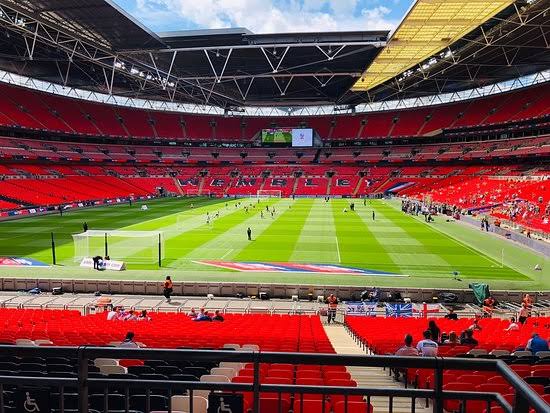
Wembley Stadium, nestled in Wembley, London, was inaugurated in 2007 on the historic footprint of its predecessor, the original Wembley Stadium, which graced the landscape from 1923 to 2003.
This iconic venue serves as the stage for significant football events, including the home matches of the England national football team and the FA Cup Final.
Owned by the Football Association (the FA) through its subsidiary Wembley National Stadium Ltd (WNSL), with the FA’s headquarters situated within the stadium, Wembley boasts the title of the largest stadium in the UK and ranks as the second-largest in Europe with a seating capacity of 90,000.
Beyond hosting England’s home games and the FA Cup final, Wembley is a hub for other pivotal matches in English football such as the FA Community Shield, the League Cup final, the FA Cup semi-finals, the Football League Trophy, the Football League play-offs, the FA Trophy, the FA Vase, and the National League play-offs.
As a UEFA category four stadium, Wembley has been the backdrop for the 2011 and 2013 UEFA Champions League Finals, eight matches of UEFA Euro 2020, including the final and semi-finals, UEFA Euro 2028, and the UEFA Women’s Euro 2022 final. It is also set to host the 2024 UEFA Champions League Final.
The stadium has a storied Olympic history, having hosted the gold-medal matches during the 2012 Olympic Games football tournament. Additionally, it’s known for the rugby league’s Challenge Cup final and an array of music concerts.
Wembley also played host to the NFL London Games up until 2019 and provided a temporary residence for Tottenham Hotspur from August 2017 to March 2019 during the construction of their new stadium.
In 2014, the stadium embarked on a six-year sponsorship deal with mobile provider EE Limited, leading to enhanced technology and infrastructure services at the venue and the official designation of “Wembley Stadium connected by EE”.
2. Old Trafford (74,310)
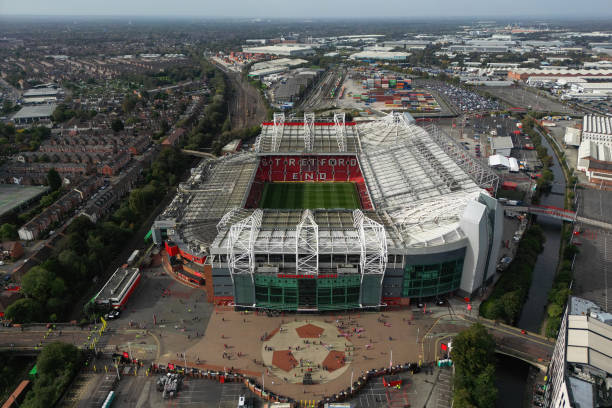
Situated in Old Trafford, Greater Manchester, England, Old Trafford stands as the hallowed home of Manchester United, one of the Premier League’s most storied clubs.
With a seating capacity of 74,310, it not only ranks as the biggest club football stadium in the United Kingdom but also the second-largest football stadium overall in the UK after Wembley Stadium, and the 12th-largest in Europe.
Coined “The Theatre of Dreams” by the legendary Bobby Charlton, Old Trafford has been the stronghold for Manchester United since 1910.
However, the club temporarily shared Maine Road with arch-rivals Manchester City from 1941 to 1949 due to damage sustained during the Second World War.
The stadium witnessed several expansions through the 1990s and 2000s, which included adding extra tiers to the North, West, and East Stands, nearly restoring the stadium to its once-held capacity of 80,000.
Plans for future expansion include potentially adding a second tier to the South Stand, which would increase the capacity to approximately 88,000.
The stadium’s record attendance was set in 1939 when 76,962 fans gathered to watch the FA Cup semi-final match between Wolverhampton Wanderers and Grimsby Town.
Old Trafford has not only hosted an FA Cup Final and two final replays but has also frequently served as a neutral venue for the competition’s semi-finals.
The stadium has been a proud host to England fixtures, games during the 1966 World Cup, Euro 96, and the 2012 Summer Olympics, marking the first instance of hosting women’s international football in its long history, as well as the 2003 Champions League Final.
Beyond the realm of football, Old Trafford has been the chosen venue for rugby league’s annual Super League Grand Final, held there every year except in 2020, and has seen the finals of Rugby League World Cups in the years 2000, 2013, and 2022.
3. Tottenham Hotspur Stadium (62,850)
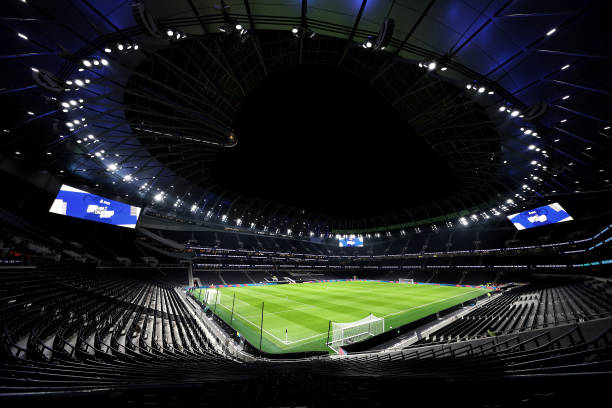
Tottenham Hotspur Stadium serves as the proud home of Tottenham Hotspur in North London, having taken the mantle from the club’s former home, White Hart Lane.
Boasting a seating capacity of 62,850, it stands as the third-largest football stadium in England and the largest club ground in London.
The stadium’s design transcends a single-purpose venue, as it also holds the distinction of being the home of the NFL in the UK.
One of its most innovative features is the world’s first dividing, retractable football pitch, which unveils a synthetic turf field beneath for hosting NFL London Games, concerts, and a variety of other events.
Initiated as the heart of the Northumberland Development Project, the stadium’s construction aimed to spark a 20-year regeneration initiative for the Tottenham area.
This ambitious project encompasses the site of the demolished White Hart Lane and its surrounding vicinity.
The idea for the stadium was birthed in 2007 and made public in 2008. However, after undergoing several revisions and facing a series of disputes and delays, construction didn’t begin until 2015.
The grand opening of the stadium was marked by a ceremony on April 3, 2019, prior to hosting its inaugural Premier League match.
While “Tottenham Hotspur Stadium” was intended as a provisional moniker, pending the acquisition of a sponsor for naming rights, the stadium has yet to be officially renamed. Nevertheless, fans and some media outlets occasionally refer to it as the New White Hart Lane.
4. London Stadium (62,500)
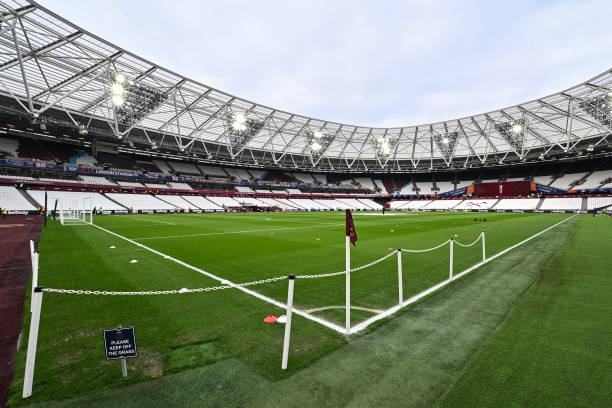
London Stadium, initially known as the Olympic Stadium and also referred to as the Stadium at Queen Elizabeth Olympic Park, is a versatile outdoor stadium situated in the Stratford district of London within Queen Elizabeth Olympic Park.
Nestled in the Lower Lea Valley, it resides 6 miles east of central London.
This stadium was purpose-built for the 2012 Summer Olympics and Paralympics, where it hosted the Athletics events and the opening and closing ceremonies.
Post-Olympics, the stadium underwent renovations to support a variety of purposes and is now predominantly the home ground for West Ham United.
5. Anfield (61,015)
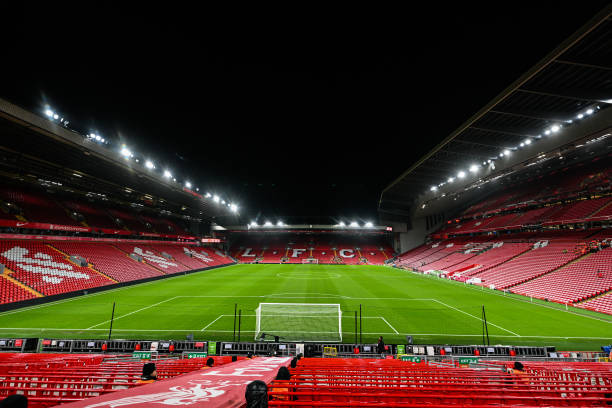
Anfield, situated in Anfield, Liverpool, England, now boasts a seating capacity of 61,015, ranking it as the 5th largest football stadium in England.
The storied stadium has been the fortress of Liverpool FC since their inception in 1892. It was originally occupied by Everton from 1884 until 1891, until they relocated to Goodison Park following a dispute with the club’s president.
Anfield comprises four stands: the iconic Spion Kop, the Main Stand, the Sir Kenny Dalglish Stand, and the recently redeveloped Anfield Road End.
The stadium’s record attendance was recorded at a match between Liverpool and Wolverhampton Wanderers in 1952, with a crowd of 61,905.
In response to the Taylor Report, Anfield transitioned to an all-seater stadium in 1994, which initially reduced its capacity.
The stadium honors its legendary former managers, Bill Shankly and Bob Paisley, with two gates named in their memory, as well as statues; Shankly’s statue is located by the Kop Stand and was unveiled in 1997, while Paisley’s statue was unveiled in 2020 by the Main Stand.
Liverpool had considered moving to a new stadium in Stanley Park in 2002, but following the club’s acquisition by Fenway Sports Group in 2010, it was decided to expand Anfield instead.
The expansion of the main stand, which opened in September 2016, was one of the largest all-seater single stands in European football and increased the stadium’s capacity to 54,074.
The capacity was further increased to 61,015 following the completion of the redevelopment of the Anfield Road Stand in December 2023.
6. Emirates Stadium (60,704)
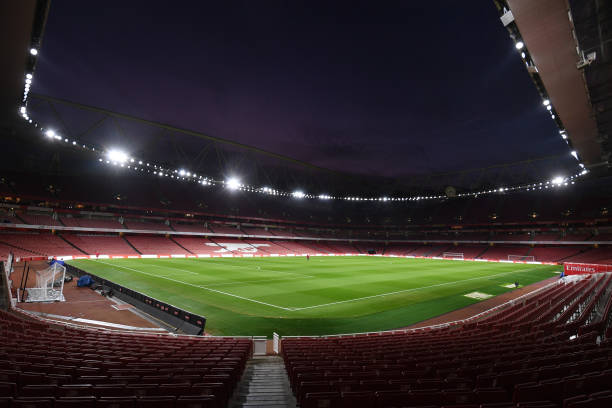
Emirates Stadium, also referred to as Arsenal Stadium for UEFA competitions, is a football venue located in Holloway, London, England, and has served as the home of Arsenal FC since its opening in 2006.
With a capacity of 60,704 seats, it is considered the sixth-largest football stadium in England.
The journey to Emirates Stadium began in 1997 when Arsenal started to explore the possibility of a new stadium after their plans to expand Highbury were rejected by Islington Council.
The club eventually purchased an industrial and waste disposal estate in Ashburton Grove in 2000 and secured the council’s approval to construct a stadium on the site in 2001, a decision Arsène Wenger hailed as a pivotal moment in the club’s history, likening it to the impact of Herbert Chapman’s appointment in the 1920s.
Although relocation plans were set in motion in 2002, financial challenges led to a delay, with construction work commencing in 2004. Emirates Airlines became the main sponsor of the stadium in a deal that contributed to the stadium’s funding.
The complete project, which culminated in the stadium’s opening in 2006, was realized at a cost of £390 million. The club’s previous ground, Highbury, was transformed into Highbury Square, a residential development.
Since 2009, the stadium has been subject to “Arsenalisation,” a process aimed at enhancing the stadium’s connection to Arsenal’s rich history.
In addition to hosting Arsenal’s home matches, Emirates Stadium has been a venue for international football and various music concerts.
7. Etihad Stadium (53,400)
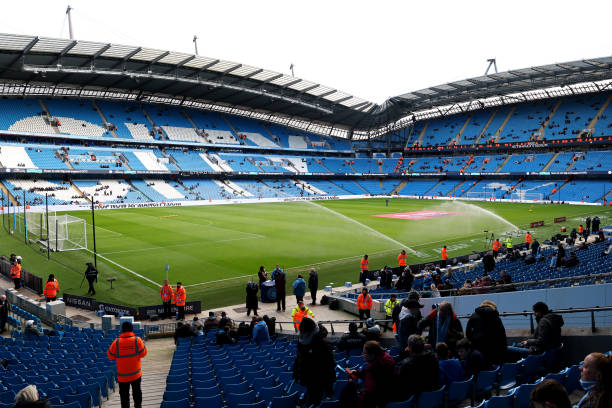
The City of Manchester Stadium, commonly known as the Etihad Stadium due to sponsorship, serves as the home ground for Manchester City FC.
Currently, it has a capacity of 53,400, which places it as the 7th-largest football stadium in England and the 10th-largest in the United Kingdom.
Originally constructed for the 2002 Commonwealth Games, the stadium has been a versatile venue, hosting events such as the 2008 UEFA Cup final, England international football matches, rugby league games, a boxing world title fight, a match of the England rugby union team during the 2015 Rugby World Cup, and various music concerts during the football off-season.
The stadium was initially conceived as an athletics stadium for Manchester’s unsuccessful bid for the 2000 Summer Olympics.
It was later converted from a 38,000 capacity arena to a 48,000 seat football stadium, a project that cost Manchester City Council £22 million and Manchester City FC £20 million.
In the summer of 2003, Manchester City moved from their old ground, Maine Road, to lease the stadium from Manchester City Council.
Laing Construction built the stadium at a cost of £112 million, with Arup providing the design and engineering, which features a distinctive cable-stayed roof supported by twelve masts and cables.
The design has been lauded, earning a Royal Institute of British Architects award in 2004 for its inclusive approach and a special award from the Institution of Structural Engineers in 2003 for its structural ingenuity.
The stadium’s capacity was increased by 7,000 seats with the completion of a third tier on the South Stand in August 2015, designed to complement the existing roof design.
A significant redevelopment of the North Stand, which includes the construction of a new 400-room hotel, a covered fan park for 3,000 people, and an increase in net capacity to 61,474, began in July 2023 and is projected to be finished by the end of 2026.
8. St. James’ Park (52,404)
St. James’ Park, situated in Newcastle upon Tyne, England, is the home stadium of Newcastle United FC. With a seating capacity of approximately 52,404, it ranks as the 8th largest football stadium in England.
The stadium has been the home of Newcastle United since 1892 and has been a venue for football since as early as 1880.
Efforts to expand St. James’ Park over the years have often led to disputes with local residents and the city council, and on several occasions, proposals were made to relocate the club.
These conflicts and the resulting reluctance to move have contributed to the stadium’s unique and uneven appearance, with its stands being asymmetrical.
St. James’ Park is not only a venue for club football and 1xbet enthusiasts; it has also hosted a range of other events, including international football during the 2012 Olympics, the rugby league Magic Weekend, rugby union World Cup matches, Premiership and England Test matches, charity football events, rock concerts, and has even served as a backdrop for films and reality television.
Previously, the stadium lacked a scoreboard or big screen following the 1993 expansion, which removed the existing one at The Gallowgate end.
However, digital time displays were added in 2007, and on October 18, 2014, a large scoreboard was installed at the Leazes End next to the Milburn Stand.
Its first use during a match against Leicester City was delayed by an hour due to safety concerns caused by high winds.
St. James’ Park was one of the venues for Euro 1996, hosting three matches, and it served as a temporary home for the England national team during the redevelopment of Wembley Stadium.
The stadium was also a venue for some football matches in the 2012 Summer Olympics and hosted two international friendlies in September 2023 between Saudi Arabia and Costa Rica, and Saudi Arabia and South Korea.
Looking to the future, St. James’ Park is set to host matches during UEFA Euro 2028.
9. Stadium of Light (48,339)
The Stadium of Light, located in Sunderland, England, is the proud home of Sunderland A.F.C. With a seating capacity of 48,339, it stands as the ninth largest football stadium in England. The stadium is dedicated primarily to hosting Sunderland’s home matches.
Named by the club’s former chairman Bob Murray, the Stadium of Light pays homage to the region’s coal mining past and the historic Monkwearmouth Colliery that once occupied the site.
A Davy lamp monument at the stadium’s entrance serves as a poignant reminder of the industry that once fueled the town’s growth.
Besides Sunderland’s fixtures, the Stadium of Light has also hosted international football, including matches for the England senior team, the under-20 and under-21 sides, as well as the England women’s national team.
Originally built with a capacity of 42,000 in 1997, the stadium was expanded in 2000 to accommodate 49,000 spectators.
Its design is notably straightforward, which allows for potential future expansions that could increase its capacity to as much as 64,000.
The record attendance at the Stadium of Light was set on April 13, 2002, when 48,353 fans witnessed Sunderland take on Liverpool, with the visiting team securing a narrow 1-0 victory.
The Stadium of Light has also been a venue for major music acts, including performances by Beyoncé, Rihanna, Oasis, Take That, Kings of Leon, P!nk, Coldplay, the Spice Girls, and Elton John.
Also, the stadium features conference and banqueting facilities, the ‘Black Cats Bar,’ and a club shop selling Sunderland merchandise.
10. Villa Park (42,573)
Villa Park, located in Aston, Birmingham, is a historic football stadium with a seating capacity of 42,640 and serves as the home ground for Aston Villa Football Club since 1897.
The stadium is conveniently situated less than a mile from both Witton and Aston railway stations.
Villa Park has a rich history of hosting significant football events, including 16 England international matches, with the first taking place in 1899 and the most recent in 2005.
Villa Park holds the record for hosting the most FA Cup semi-finals, which stands at 55, making it a stadium with a strong association with this prestigious competition. It is also recognized as the 10th largest stadium in England.
The origins of Villa Park date back to when Aston Villa moved into the Aston Lower Grounds.
These grounds were part of a Victorian amusement park located within the estate of the Jacobean stately home, Aston Hall.
Since then, the stadium has undergone several renovations and now comprises the Holte End, Trinity Road Stand, North Stand, and Doug Ellis Stand.
Before the First World War, the stadium featured a cycling track around the pitch and was a venue for regular cycling and athletic events.
Villa Park has been utilized for various events beyond football, including concerts, boxing matches, and international rugby league and rugby union matches.
In 1999, it was the chosen venue for the last final of the UEFA Cup Winners’ Cup.
The stadium also hosted the 2012 FA Community Shield while Wembley was occupied with the Olympic football tournament.
Looking towards the future, Aston Villa has ambitious plans to redevelop the North Stand.
This redevelopment is expected to increase Villa Park’s capacity to over 50,000 and will include a new commercial and entertainment complex known as “Villa Live.”
These redevelopment plans were approved by Birmingham City Council in December 2022, with the aim to complete the renovations in time for UEFA Euro 2028.
ALSO READ:







